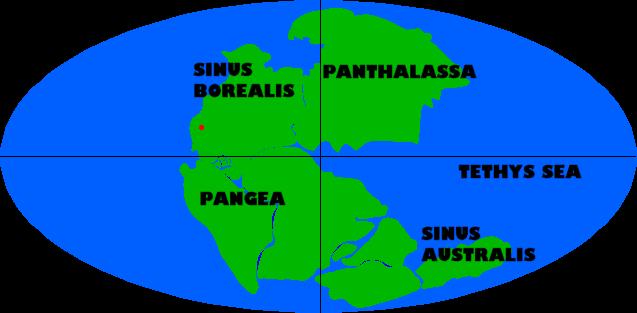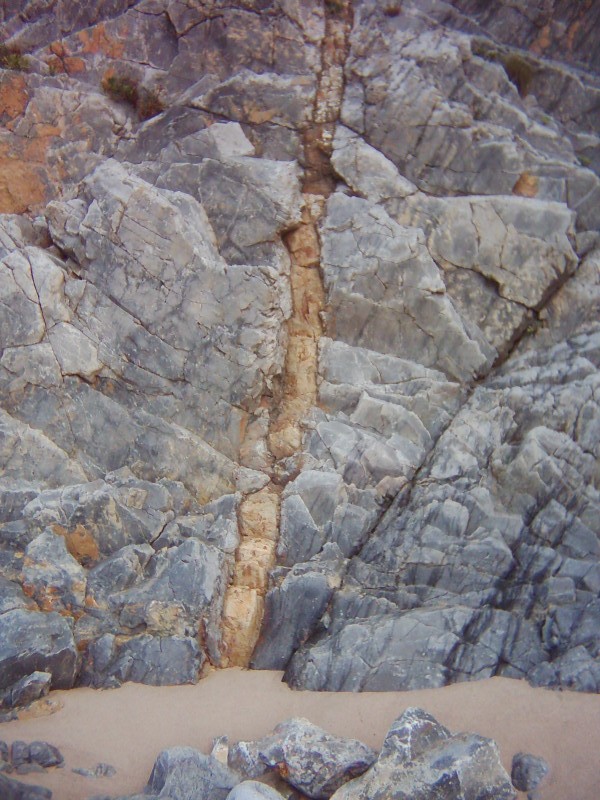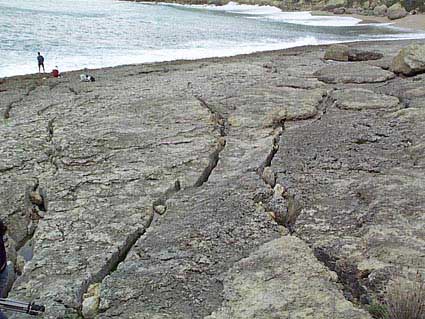[PT] A
enseada está enquadrada dentro da Bacia Lusitaniana, que por sua
vez está inserida numa das três principais unidades geológicas de
Portugal Continental, mais concretamente na Orla Meso-Cenozóica
Ocidental.
Segundo Galopim de Carvalho (2003), a Bacia
Lusitaniana é de origem Mesozóica, sendo mais precisos, Triásico
Superior, datado entre os 220 Ma (na figura) e 230 Ma, tendo-se
instalado numa fossa alongada de direcção NNE-SSW.
[EN]
The bay is framed within the Lusitanian Basin, which in turn is
within one of the three main geological units of Mainland Portugal,
specifically in the Meso-Cenozoic West Rim.
According to Galopim de Carvalho (2003), the
Lusitanian Basin is of Mesozoic origin, being nore accurate, Upper
Triassic, dated between 220 Ma (in the picture) and 230 Ma, having
been installed in an elongated pit NNE-SSW.

[PT] Este local encontra-se
num ambiente de plataforma carbonatada, estando esta basculada e
metamorfizada (sendo o seu metamorfismo de contacto), e tal é
explicado pela intrusão de um corpo magmático, nomeadamente a Serra
de Sintra, que tem cerca de 82 Ma, sendo portanto, de idade
Neo-Cretácico.
Nesta enseada observam-se filões em que dois
dos quais formam uma estrutura em X, pois aproveitam as direcções
de diaclases para se instalar.
Os filões (figura da esquerda) são corpos magmáticos, de forma
tabular, resultantes do preenchimento de fracturas existentes nas
rochas. A sua atitude e dimensões são variáveis, podendo apresentar espessuras que
variam entre poucos milímetros (filonetes) a alguns metros ou mesmo
quilómetros e extensões desde alguns metros até quilómetros. A sua
espessura nem sempre é constante e por vezes ramificam-se.
Observam-se, frequentemente, variações
texturais e mineralógicas num mesmo filão.
[EN] This site is in a carbonate
platform environment, which is tilted and metamorphosed (being its
metamorphism of contact), and this is explained by the intrusion of
a magmatic body, namely "Serra de Sintra", which has about 82 Ma,
so it is of Neo-Cretacic age.
In this bay are
observed veins in which two of those from a X structure, because
they took advantage of diaclasite directions to
settle.
The veins (left
picture) are magmatic bodies, in tabular form, resuling from the
completion of existing fractures in rocks. Its attitude and
dimentions are variable, and may have thicknesses and stretches
from a few meters to kilometers. Its thickness is not always
constant and sometimes branch out. It is frequent to observ
textural and mineralogical variations in the same vein.


[PT] As diaclases
(figura da direita)
são fracturas que dividem as rochas em blocos e em relação às quais não se produziu deslocamento ou
o deslocamento foi mínimo. Todas as rochas desde a sua formação
estiveram submetidas a esforços de compressão, tracção e
torsão que deram origem a um conjunto de fracturas designadas por
diaclases. Desenvolvem-se sobretudo nas rochas duras,
intersectando-se em diversas direcções sendo algumas principais e
originando uma rede de fracturas que facilita a sua separação em
blocos e, portanto, a sua desagregação. Não devem ser confundidas
com falhas e/ou fracturas.
A rocha
encaixante destes filões é um calcário que dá pelo nome de
«Calcário de Mem Martins». Os «Calcários de Mem Martins»
correspondem a calciturbiditos proximais, depositados em talude
recifal, cujo recife seria constituído, essencialmente, por
bioermas algais, do tipo estromatolítico.
[EN] The diaclasites (right picture) are
fractures that divide the rock into blocks and for which
displacement is not produced or, if produced, is minimal. All rocks
since their formation have been subjected to compression, tension
and torsion that resulted in a series of fractures known as
diaclasites. It is mainly formed in hard rocks, intersecting in
various directions, some of them main directions, and resulting in
a network of fractures which facilitates its separation into
blocks, and therefore, its breakdown. Not to be confused with
faults and/or fractures.
The surroundind
rock (of the veins) is a limestone that is named "Mem Martins
Limestone". "Mem Martins Limestone" match to proxial
calciturbidites, deposited in reef slope, which reef would consist,
mainly, by algae bioerms, like
stromatolic.
[PT] Para poderem fazer o found desta cache terão de responder
às seguintes questões e enviá-las para o nosso e-mail:
1 - Quantos filões observa na estrutura
em X?
2 - Observando a estrutura em X, esta
encontra-se cortada, indique o número de filões que a
cortam.
3 -O(s) filão(ões) que corta(m) a
estrutura em X é/são anterior(es) ou posterior(es) aos que formam o
X?
4 - Indique a
orientação geral da parede onde a estrutura em X se
encontra.
5 - Qual a distância
aproximada (em metros) do centro do X ao chão?
6 - Tirem uma foto
vossa ou do vosso GPS na zona do afloramento (apenas a colocam
aquando autorização para fazer o found).
[EN] In order to make your
found you have to answer
these questions and send the answers to our
e-mail:
1 - How many veins do
you observ in the X structure?
2 - Observ the X
structure, it is cuted, indicate how many veins cuts it.
3 - The vein(s) that
cuts the X structure is/are prior or posterior to the ones that
form the X?
4 - Indicate which is
the general orientation of the wall that has the X
structure.
5 - What is the
aproximate distance (in meters) from the ground to the center of
the X?
6 - Take a picture of
you or of your GPS in the zone of the outcrop (only place them when
you have permission to log your found).
[PT] NOTA:
Não façam esta cache com mau tempo, principalmente se estiver a
chover. Mantenham-se nos trilhos para não se magoarem. Não
necessitam de descer a enseada para fazer a cache, no entanto se o
fizerem tenham muito cuidado.
[EN] NOTE:
Do not do this cache in bad weather, especially if it is raining.
Keep on the paths so that you do not get hurt. You do not need to
go down to bay to do the cache, although if you do please be very
careful.